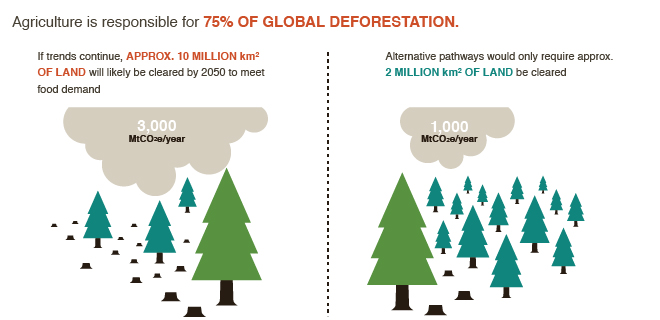Emissions from Forestry and Land Use

Facts
- Land-use change is a highly complex process. It results from the interaction of diverse drivers that may be direct or indirect and can involve numerous transitions, such as clearing, grazing, cultivation, abandonment and secondary regrowth (Gerber et al. 2013).
- Deforestation and land-use change accounts for 2,200–6,600 million tonnes of carbon dioxide (CO2) equivalent per year, or 30–50% of agricultural emissions and about 4–14% of global emissions (Vermeulen et al. 2012, based on van der Werf et al. 2010 and Blaser and Robledo 2007).
- Land-use change to produce feed for livestock accounts for about 9% of livestock-sector emissions (Gerber et al. 2013)
- Changes to forestry and other land use accounted for about a third of anthropogenic CO2 emissions since the pre-industrial era. (Foley et al. 2005).
- Past trends imply that about 10 million square kilometres of land will be cleared by 2050 to meet food demand, leading to annual emissions of 3,000 million tonnes of CO2 equivalent. Reducing land clearing to about 2 million square kilometres would reduce greenhouse gas emissions to 1,000 million tonnes of CO2 equivalent per year (Tilman et al. 2011).
Sources and further reading
- Blaser J, Robledo C. 2007. Analysis on the mitigation potential in the forestry sector. Prepared for the UNFCCC Secretariat. Bern: Intercooperation. (Available from http://unfccc.int/files/cooperation_and_support/financial_mechanism/application/pdf/blaser.pdf) (Accessed on 6 November 2013)
- Foley, JA, DeFries R, Asner GP, Barford C, Bonan G, Carpenter SR, Chapin FS, Coe MT, Daily GC, Gibbs HK, Helkowski JH, Holloway T, Howard EA, Kucharik CJ, Monfreda C, Patz JA, Prentice IC, Ramankutty N, Snyder PK.2005. Global consequences of land use. Science 309:570–574. (Available from http://dx.doi.org/10.1126/science.1111772)
- Gerber PJ, Steinfeld H, Henderson B, Mottet A, Opio C, Dijkman J, Falcucci A, Tempio, G. 2013. Tackling climate change through livestock – A global assessment of emissions and mitigation opportunities. Rome: Food and Agriculture Organization of the United Nations. (Available from http://www.fao.org/docrep/018/i3437e/i3437e.pdf) (Accessed on 6 November 2013)
- Tilman D, Balzer C, Hill J, Befort BL. 2011. Global food demand and the sustainable intensification of agriculture. PNAS 108(50):20260–20264. (Available from www.pnas.org/cgi/doi/10.1073/pnas.1116437108) (Accessed on 6 November 2013)
- van der Werf GR, Morton DC, DeFries RS, Olivier JGJ, Kasibhatla, PS, Jackson RB, Collatz GJ, Randerson JT. 2009. CO2 emissions from forest loss. Nature Geoscience 2:738–739. (Available from http://biology.duke.edu/jackson/ng09.pdf)
- Vermeulen SJ, Campbell BM, Ingram J SI. 2012. Climate change and food systems. Annual Review of Environmental Resources 37:195–222. (Available from http://www.annualreviews.org/doi/abs/10.1146/ annurev-environ-020411-130608) (Accessed on 6 November 2013)